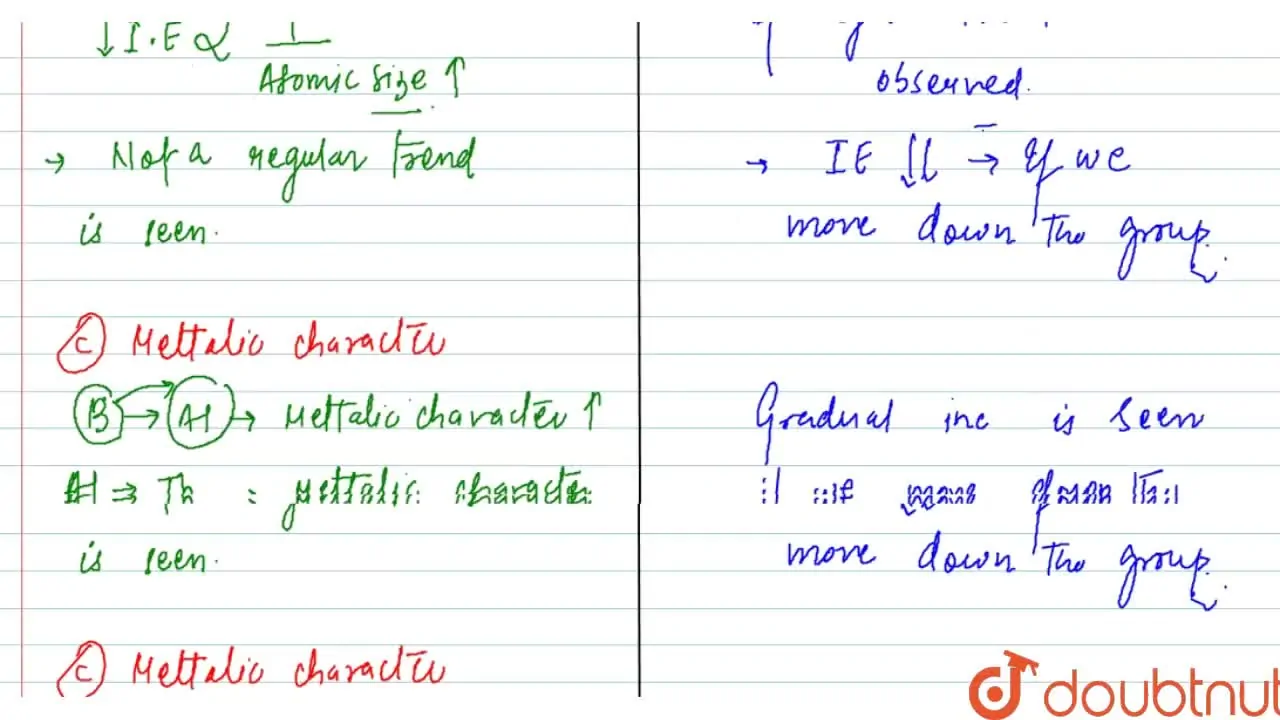Describe the general trends in the following properties of the elements in groups 13 and 14
(a) Atomic size
(b) Ionisation enthalpy
(c) Metallic character
(d) Oxidation states
(e) Nature of halides.
For Group 13
(a) Atomic size On moving down the group for each successive member, one extra shell of electrons is added and therefore, atomic radius is expected to increase. However, a deviation can be seen
Atomic radius of Ga is less than that of Al due to presence of additional 10d- electrons, which offer poor screening effect to the outer electron
(b) Ionisation Enthalpy The ionisation enthalpy values as expected form general trends do not decrease smoothly down the group. The decrease form B to Al is associated with increase in size
To observed discontinued between Al and Ga and between In and Tl due to low screening effect of d and f-electrons which compensates increased nuclear charge
(c) Metallic or Electropositive Character Boron is semi-metal (melalloid) due to very high ionisation enthalpy. All others are metals and metallic character first increases from B to Al as size increases. From Al to Tl decrease due to poor shielding of d- and f-electrons
(d) Oxidation States As we move down the group, the stability of +3 oxidation state decreases while that of +1 oxidation progressively increases. In other words, the order of stability of +1 oxidation state increase in the order. Al<Ga<ln<Tl. Infact, in Ga, ln and Tl, both +1 and +3 oxidation states are observed.
(e) Nature of Halides These elements react with halogens to form trihalids (except Tll3)
2E(s)+3X2(g)→2EX3(s) [X=F,Cl,Br,l]
Boron in halides are electron deficient molecules and behaves as Lewis acids. The Lewis character decreases in the order : Bl3>BBr3>BCl3>BF3
For Group 14
(a) Atomic Size There is considerable increase in covalent radius from C to Si therafter from Si to Pb as small increase in radius is observed. This is due to the presence of completely filled d and f-orbitals in heavier member.
(b) Ionisation Enthalpy The first ionisation enthalpy of group 14 members is higher than the corresponding members of group 13. The influence in inner core electrons is visible here. In general the ionisation enthalpy decreases down the group, Small decrease in Δ,H from SI to Ge to Sn and slight increase in Δ,H from Sn to Pb is the consequence of poor shielding effect of intervening d and f-orbitals and increase in size of the atom.
(c) Metallic Charter Metallic character increases down the group C (non-metal) Si, Ge (metalloid) Sn, Pb(metals)
(d) Oxidation States The group 14 elements have four electrons in the outermost shell. The common oxidation states exhibited by these elements are +4 and +2. Carbon also exhibits negative oxidation states. Since the sum of the first four ionisation enthalpies is very high, compounds in +4 oxidation states are generally covalent in nature. In heavier members the tendency to show +2 oxidation state increases in the Ge<Sn<Pd due to inert pair effect
(e) Nature of Halides These elements can form halides of formula MX2 and MX4 (where, X = F,Cl,Br,l). Except carbon, all other members react directly with halogen under suitable condition to make halides
Most of MX4 are covalent with sp3 hybridisation and tetrahedral in structure. Exceptions are SnF4andPbF4 which are ionic in nature. Heavier members Ge to Pb are able to make halides of formula MX2. Stability of halides increases down the group.
Related Playlists
- BOOK - NCERT EXEMPLAR ENGLISHCHAPTER - THE P-BLOCK ELEMENTSEXERCISE - Assertion and Reason2videos
THE P-BLOCK ELEMENTS
- BOOK - NCERT EXEMPLAR ENGLISHCHAPTER - STRUCTURE OF ATOMEXERCISE - All Questions55videos
STRUCTURE OF ATOM
- BOOK - NCERT EXEMPLAR ENGLISHCHAPTER - THE S-BLOCK ELEMENTS EXERCISE - Long Answer Type Questions8videos
THE S-BLOCK ELEMENTS
Similar Questions
(a) Describe the general trends in the following properties of the first series of the transition elements:
(i) Stability of +2 oxidation state (ii) Formation of oxometal ions
(b) Assign reason for each of the following:
(i) Transition elements exhibit variable oxidation states.
(ii)Transition metal ions are usually colouredView SolutionDecribe the general trends in the following properties of the first sereis of the transition elements :
(i) Stability of + 2 Oxidation state
(ii) Formation of oxometal ions.View SolutionWhich of the following properties of the elements of group II (alkali earth metals) increase (s) with increasing atomic number?
View SolutionName the elements of group 17. Describe the trend in the properties of halogens such as:
(a) Bond energy
(b) Ionization enthalpy
(c) Oxidising power
(d) Reactivity and
(e) Reducing power of halogen halides.View SolutionDiscuss the following trends in halogens.
(a) atomic radius
(b) ionisation potential
(c) electron affinity and
(d) electronegativity.View SolutionWhich of the following is affected by the stable electron configuration of an atom?
(a) Electronegativity (b) ionisation enthalpy (c ) Electron gain enthalpy
Correct answer is:View SolutionGeneral oxidation state shown by group 13 elements is
View SolutionWhich of the following properties of IA group metals increases as the atomic number rises:
(a) Metallic character (b) Ionic radius
(c ) Melting point (d) Density
(e ) Ionization potential
Correct answer is:-View SolutionCompare the alkali metals and alkaline earth metals with respect to (a) ionisation enthalpy, (b) basicity of oxides and (c ) solubility of hydroxides.
View SolutionAnswer the following :
(a) Name of element of group 13 which forms the most stable compound in +1 oxidation state. .View Solution


